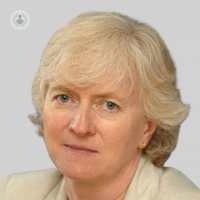All about venous insufficiency - what is it and how is it treated?
Written in association with:Venous insufficiency is a problem where the valves in the veins of the leg don’t work in the way they should. Fluid pools in the legs and can lead to complications such as varicose veins. Miss Sophie Renton, expert Consultant Vascular Surgeon, explains further.

What is venous insufficiency?
The heart pumps the blood to the legs through arteries. Veins are responsible for carrying blood back to the heart. Veins do not have a pump like the heart, instead, the flow is pushed up by the pumping action of the muscles in the leg. Inside the veins, there are fine valves which prevent the blood from falling back down the vein when you stand up and when your calf muscles are not working.
If these valves fail, either because the vein becomes stretched as in varicose veins, or the vein is damaged by a deep vein thrombosis, blood does fall back down inside the vein when you stand. This is “reflux” and we look for this when we do an ultrasound scan. Leaky valves cause the pressure in the veins to go up. This results in a slow leakage of fluid into the tissues, the cause of the symptoms and signs of venous insufficiency.
What are the causes of venous insufficiency?
Venous insufficiency is caused by varicose veins and the side effects of deep venous thrombosis.
• Varicose veins are dilated surface veins in which the valves no longer work. Varicose veins occur in 40% of the population. Sometimes, they run in families. Varicose veins can occur in the late teens and are present with increasing frequency as you get older. Some people can have large ugly varicose veins and no symptoms. Once you start to get symptoms, they are unlikely to go away but can be relieved by compression socks or treatment. The symptoms of varicose veins are tired heavy legs, especially at the end of the day, restless legs, itching, skin discolouration, eczema, painful lumps, ulcers and swelling of the ankles.
Find out about how Ms Renton treats varicose veins in this case study
• Deep vein thrombosis can occur spontaneously or as a result of inactivity such as on long haul flights or a surgical operation. If you develop a deep vein thrombosis, the valves inside the affected vein will be destroyed leaving that segment of the vein leaky. This results in the post thrombotic syndrome. This is characterised by swelling of the ankle and lower leg, skin discolouration, venous eczema, and irritation. It may result in ulceration.
How can venous insufficiency be diagnosed?
If you are suspected of having venous insufficiency, you should be assessed by a Vascular Specialist. This doctor or surgeon will take a history and examine your legs. He/she will either perform an ultrasound in clinic or send you to a vascular technologist for a scan. The scan assesses how your veins are working and which, if any, are not working properly.
What is the treatment plan like?
This will depend on the pattern of disease. Most varicose veins can be treated but there are several different treatments and your specialist will discuss a plan that is appropriate to you. This may include treatment to close off the drainage veins in the thigh or behind the knee as these are usually the culprits in varicose veins. Treatments include radiofrequency or laser ablation where heat is used on the inside of the vein to close the vein down.
Alternatively, mechanochemical ablation may be proposed. This technique uses a special wire to destroy the lining of the vein. The newest technique is glue – a medical equivalent of superglue is used to shut down the vein. Branches arising from the drainage vein may be treated by local removal or sclerotherapy i.e injection treatment. Most treatments can be done as a daycase, under local anaesthetic or sedation and surgery is rarely necessary.
Unfortunately, if veins are damaged by a deep vein thrombosis, they cannot be repaired. The mainstay of treatment is to keep the swelling down with compression socks and get ulcers to heal with special bandages.
Is there any way to prevent venous insufficiency?
Unfortunately not. Varicose veins occur because you have a susceptibility to develop them. Deep vein thrombosis is a recognised risk in hospital patients and all patients admitted to hospital are risk assessed and given preventative measures to try and prevent them developing a deep vein thrombosis.
If you would like to book a consultation with Ms Sophie Renton, you can do so today via her Top Doctors profile.


